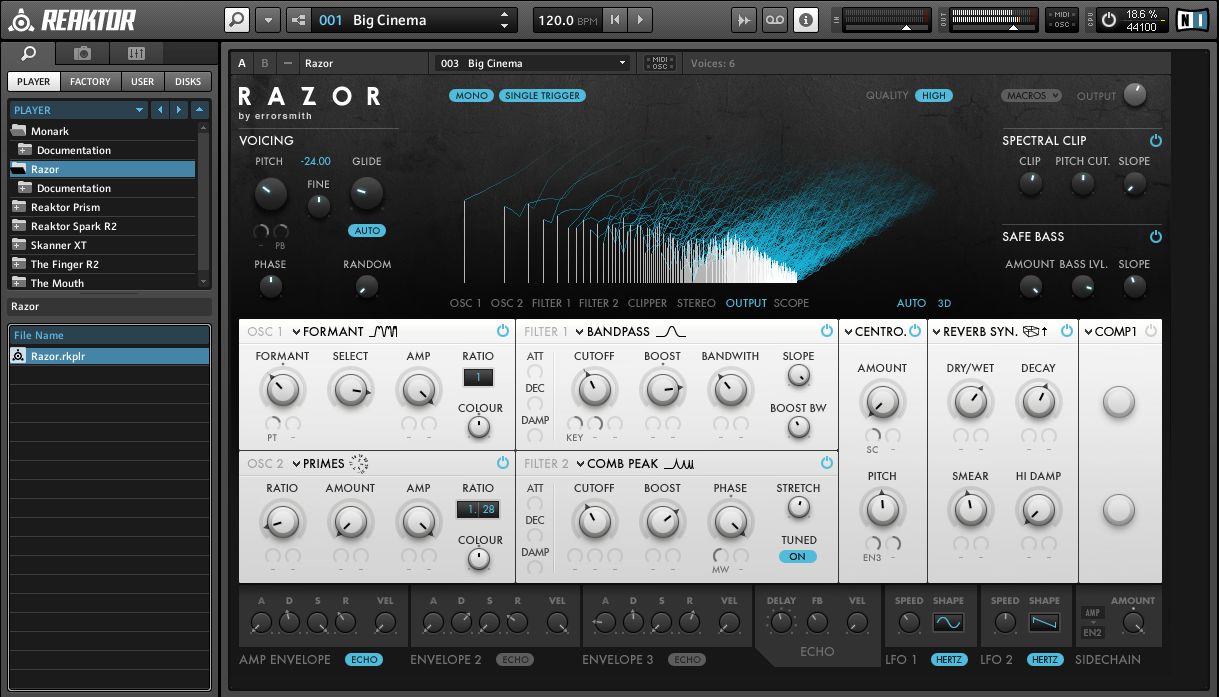
REAKTOR RAZOR FULL
Reaktor owners will have to weigh its authenticity against a user library full of vintage emulations.
REAKTOR RAZOR UPGRADE
While Monark may not be enough to entice Komplete owners to upgrade on its own merits, it does sweeten the pot. The included patches do an excellent job of providing some inspiration, but it's so easy to roll your own that you may never get around to using them. Monark doesn't represent anything new at all for most potential users, but any grumbling about its presentation and subject matter has to be offset by the fact that it sounds superb. Snapshots, MIDI assignments, OSC control and more are available however, we'd still prefer it if Monark was a self-contained, non-Reaktor plugin. Plus, of course, you get all of the benefits of either Reaktor or Reaktor Player, depending on which you're using with Monark.
REAKTOR RAZOR MOD
In addition to the added filter modes, you can choose from two Glide modes (MM, acting like the original, and Silver, with which the glide time is constant, irrespective of note range) and two Legato modes, while a Settings view enables editing of pitch and mod wheel response curves, oscillator leakage and drift, key-tracking and more. There are other optional deviations from the Minimoog architecture, too. To say that the filter sounds authentic would be an understatement - it's absolutely stunning it's clear that we're hearing the benefits of Dr SynC's ZDF expertise. As with the original, you can apply two levels of key modulation and also connect the filter to the OSC3/Noise mod mix. Importantly, the filter can be made to self-oscillate - an all-too-rare feature among soft synths. Of course, the Mini's 24dB low-pass model is here and spotlighted, but you can also choose from two more low-pass filters (6 and 12dB) or a 12dB band-pass, each of which sounds significantly different to the Minimoog filter. The filter section is the highlight of the instrument. "To say that the filter sounds authentic would be an understatement - it's absolutely stunning"

The Mixer section of the Mini is recreated 1:1, with white/pink noise, overdrive via the Load control, and a Feedback knob for mimicking the aforementioned effect created by routing the output back into the filter - this can summon up some serious grit and filth when pushed.


Each oscillator's key-tracking varies a little, too, just as it does on a real Moog. Interestingly, the waveforms have been tweaked so that a sawtooth on one oscillator will have subtly different harmonic content to that of another, and the same goes for all the waveforms.

The Mini's selection of six waveforms are emulated (with Osc 3 getting a reverse saw that mirrors that of the other oscillators), and so are all six pitch ranges. The design is true to the Minimoog save a few small differences, many of them behind the scenes. Simple and direct, it's virtually impossible to make a bad sound with a Minimoog.Īnd so to Monark. The Mini was monophonic, but glide could be used to sweep between the pitches of notes for a distinctive legato sound, and the filter could be overdriven in the loveliest way by routing the headphone output back through the external input, causing a feedback loop. One was hardwired to the amplifier, the other to the filter cutoff. Two envelope generators offered attack, decay and release stages.
REAKTOR RAZOR GENERATOR
The oscillators, along with a noise generator and external signal input, were routed through a mixer, then into a 24dB resonant low- pass filter. For those who don't know, the original Minimoog was a three-oscillator analogue synthesiser with the third oscillator doubling as an LFO (though all of them could be switched into Lo mode for this purpose).


 0 kommentar(er)
0 kommentar(er)
